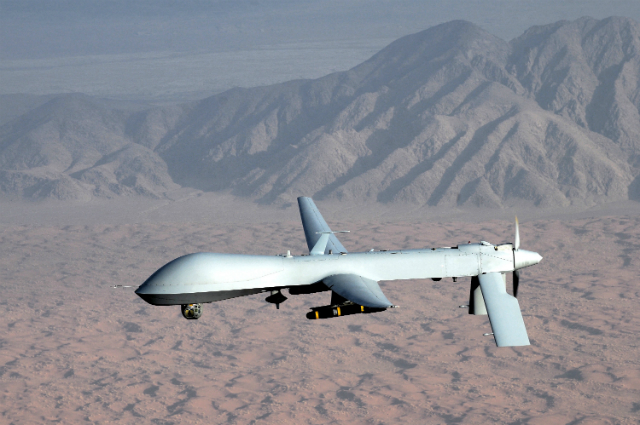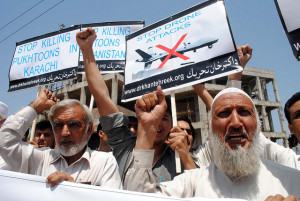by James A. Russell
The confirmation hearings of John Brennan for director of the Central Intelligence Agency serve as the latest searing reminder of the intellectual rigamortis gripping the national security establishment and how brain dead we have become as a country in addressing strategy and strategic issues.
The sole focus of these hearings has been the country’s ongoing love affair with targeted assassinations carried out by drones against our Islamic extremist adversaries.
Instead of engaging in a real debate over the efficacy of these assassinations as an element of counter-terrorism strategy, we are left with the voices of Republicans who see nothing wrong with the state drawing up its monthly assassination lists and those of Democrats who worry about civil rights issues and want judges to review who the government proposes to assassinate each month.
If ever there was an example of tactics in search of a strategy, this is it. Sadly, this is only the latest example of the national security establishment confusing the two.
This country has witnessed the substitution of tactics for strategy during the last decade as a series of military and civilian leaders have trumpeted the benefits of “counterinsurgency strategy” as the correct approach to our wars in Iraq and Afghanistan. Yet counterinsurgency is nothing more than a tactical approach on the battlefield, which, by the way, has mostly failed miserably when attempted by western militaries over the last century. It is not a strategy.
Killing terrorists by whatever means is also tactics masquerading as strategy — just like counterinsurgency. Our focus on assassinating suspected terrorist foes both by hellfire missiles from above and by Special Forces kicking in doors on the ground in fact reflects a specific approach to counter-terrorism called leadership decapitation. You won’t hear this mentioned in the hearings — but this is the strategic issue under discussion, without, of course, being discussed.
Leadership decapitation as a strategy is short-sighted, bound to ultimately fail, and may in fact increase threats to our country. What is the evidence to support this assertion and where has leadership decapitation been tried? The answer exists in almost every irregular war undertaken by occupying armies over the last century. The French perfected the technique during their occupation of Algeria in one celebrated example, though that war didn’t turn out well for them. Another current day example is Israel, which has routinely assassinated its adversaries in its futile attempt to prevent terrorist attacks over the last 60 years. Just as the French could not kill their way to victory in Algeria, Israel cannot kill its way to peace and security.
Although you might not realize it, the United States is by far the greatest modern day practitioner of leadership decapitation. How has this strategy worked out for us and why isn’t Brennan being asked about it in his confirmation hearings?
I recall sitting in on a briefing in Afghanistan back in 2010 and seeing the obligatory power point slide with all the red “X’s” through the Taliban’s leadership structure in the province I was visiting. Stupidly, of course, I mentioned to the briefer: “Well, we must be winning, then.” He laughed and responded: “You could have shown up here for every year for the last few years and seen the exact same slide. They just keep coming back.”
Therein lies the problem. The US has implemented the tactic of leadership decapitation on an industrial scale in Afghanistan over the last three years under the military leadership of General Stanley McChrystal and then his successor, David Petraeus. Both unleashed the Joint Special Operations Command (JSOC) in Afghanistan just as they did in Iraq. In Iraq during 2007 and 2008, JSOC killed many Iraqis, which helped cover the US retreat but that’s about it. JSOC teams and the CIA drone mavens have also killed a lot of the Taliban, but has the Taliban given up?
Setting aside the moral and ethical issues related to state assassinations of people without due process, the broader strategic issue remains — we can’t kill our way out of disputes with Islamic militants that are currently on the receiving end of our hellfire missiles. They will keep coming back until a political settlement is reached or until they are all dead. Since we can’t kill them all, the war will go on.
Still worse, by intervening in what are essentially local political disputes in countries like Yemen, Mali and Afghanistan, we run the risk of provoking exactly the kind of attacks against us that we are supposed to be trying to forestall.
Leadership decapitation is a prescription for never ending war, which may be useful for political purposes in some US quarters (like it is in Israel), but remains a terrible strategy. Just ask the Israelis how it has worked out for them. Despite the comforting illusion of the cost-free, push-button war offered by our standoff drone strikes and our darkly clad soldiers jumping out of helicopters to gun down suspected terrorists, we are playing a dangerous game that may only increase threats to this country.
As much as we might want to believe otherwise, there is no military solution to the political problem of extremist violence. It is a square peg being inserted into a round hole. Al Qaeda-inspired militancy around the Islamic world is at heart a violent protest against modernity that commands no broadly based popular political support. Do we see Saudi citizens (or any citizens, anywhere, for that matter) mounting the barricades in a revolution supporting Al Qaeda’s call for a return to the caliphate? We should let Al Qaeda die its natural death. If anything, America’s military interventions in the developing world have prolonged the relevance of the handful of militants flocking to this banner.
At the very least, sound strategic thinking would deliver us the kind of debate that is so desperately needed on the strategic choices facing this country as we try to decide how best to protect ourselves. The recent confirmation hearings offered us the chance to explore these issues, but the silence from both the executive and legislative branches is deafening.
This country is tumbling into a de facto era of apparently endless drone wars with no critical assessment or alternative views being offered. It’s hard not to draw the parallel to Joseph Conrad’s Heart of Darkness, with the United States ceaselessly lobbing missiles into an unpoliceable, dark, and impenetrable interior just as the ship did in Conrad’s story — firing away futilely at unseen targets in a world gone mad.






Great post – there are times US strategic thinking is in a hole with the sides caving in, scrambling up the debris, but falling further into a narrower and narrower way of thinking.
Quite so. I marvel at someone in Monterey CA talking
this way, but of course there *are* intelligent people
in the US of A. God I wish the States would return
to their role of being brave, and being good guys.
Counterinsurgency is not only a tactic, it is a tactic which must rely on fear to obtain any advantage- an advantage which can only be short term, since it will almost always lack a positive purpose to grip the hearts and minds of the people.
“Al Qaeda-inspired militancy around the Islamic world is at heart a violent protest against modernity…”
Is the dissemination of (economic) neoliberalism for the profit of US greedy “elite” “modernity” ?